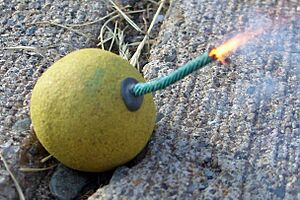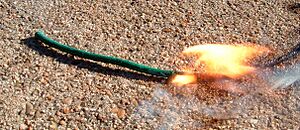Fuse (explosives) facts for kids

In things like explosives, fireworks, or military equipment, a fuse is the part that makes the device begin its job. People often use the word "fuse" for everything. But if you want to be exact, especially in the military, a fuse is a simple device that uses fire to start something. Think of the cord on a firecracker.
The word fuze is used for more complex starting devices. These might have mechanical or electronic parts. Examples include a proximity fuze for an artillery shell, a magnetic fuze on a sea mine, or a spring-loaded grenade fuze.
History of Fuses
The first fuses were likely used by the Song Chinese. This happened between the 10th and 12th centuries. After the Chinese invented gunpowder, they started using it for military tools. By 1044, they were using gunpowder in simple grenades, bombs, and flamethrowers.
The simplest fuse is the burning fuse. It probably came from the 10th century in China. This early fuse was light paper filled with loose gunpowder. It helped delay the start of fireworks. You can still find this simple burning fuse in many modern fireworks.
A type of this simple fuse is called visco fuse. It has a burning core covered with wax or lacquer. This makes it stronger and water-resistant. Early fuses for grenades were also wooden plugs. They had a hole filled with a slow-burning gunpowder mix. These were used until the 18th century.
A commercial and military burning fuse is called a safety fuse. William Bickford invented it. It is a fabric tube filled with material that burns. It is wrapped to keep the burning part safe from outside. Safety fuses help start explosives using a blasting cap.
Modern Safety Fuses
Today's safety fuses are often used in mining and military work. They create a time-delay before something ignites. They usually start an explosive detonator. This begins a chain reaction to set off a larger, more stable main charge.
Safety fuses are typically green or black for military use. Commercial ones are often bright orange. This helps tell them apart from detonating cords like Primacord. Detonating cords are brightly colored or clear.
Where Fuses Are Used
Fuses are found in many places. You can see them in fireworks, model cannons, and old matchlock firearms. They are also used in some improvised explosive devices.
Types of Fuses
There are many different kinds of fuses, each with a special job.
- A slow match is a very slow-burning fuse. It is a hemp or cotton rope soaked in a chemical like potassium nitrate. Slow matches are used to light other devices by hand. This includes matchlock guns or fuses on black powder cannons. They were good for old weapons because they wouldn't go out easily. They also only showed a small glow, not a big flame. This was safer near gunpowder.
- Today's punks are a type of slow match. They are wood sticks covered with plant material or animal waste. Then they are soaked in nitrate. Punks are used for lighting consumer fireworks.
- A black match is a fuse made of cotton string. It is coated with a dried mix of black powder and glue. This acts as a simple way to pass fire. It was used to fire old cannons. Today, it is used in making fireworks.
- A quick match or piped match is a very fast-burning black powder fuse. It can burn hundreds of feet per second. It is a black match covered with a loose paper wrap (a pipe). When lit, the flame quickly moves down the paper pipe. This happens because of the hot gases from the burning powder. Quick matches are used in professional fireworks shows. They pass fire almost instantly between devices that need to fire at the same time.
- A visco fuse has a core of black powder. It has one or more fabric layers wrapped around it. The outer layers might have wax or nitrocellulose lacquer. This makes them water-resistant. These fuses are widely used in modern pyrotechnics. They burn at a steady rate with a flame you can easily see. Good quality visco fuses can even burn reliably underwater once lit. This is because the black powder core has its own fuel and oxygen.
- A safety fuse has a black powder core inside a fabric tube. It is covered with asphalt or another waterproofing material. It also has a strong outer fabric or plastic wrap. They are made in a standard size to fit into blasting caps. Once lit, safety fuses will burn underwater. They have no outside flame. This is important because it prevents igniting gases like methane in mines. Safety fuses are made to burn at a specific speed. For example, a 30 cm (about 1 foot) fuse might take 60 seconds to burn. Manufacturers warn that burn times can change. So, safety measures should always be used.
- An electric match (sometimes called Igniter Safety Fuse Electric or ISFE) lights a main fuse or device with electricity. They usually have two wires leading to a thin wire that heats up when electricity flows. This hot wire is covered with a small amount of pyrotechnic material. This material ignites from the heat. It then provides enough fire to light the main fuse or device. Estes model rocket motors are lit by a type of electric match. Large fireworks shows use computers to control electric matches. This helps them launch fireworks with exact timing.
- A flying fish fuse (also called a bumblebee) is a special fireworks part. It is made like Visco fuse. But it has a metallic spark mix or other effect instead of black powder. Flying fish can be a main effect, not just a starter. For example, lighting a short piece on the ground makes it fly around. It seems to swim in random ways while making sparks and noise. A fireworks shell filled with many of these pieces creates a beautiful sight in the air.
- A spolette is a delay fuse. It is a hollow wooden dowel or paper tube packed with black powder. A spolette is glued into a fireworks shell. It is lit by the lift charge that sends the shell into the air. After a delay, which lets the shell reach its highest point, the spolette lights the shell's main effect. The strong wood helps the fuse burn reliably. This is true even with the force and speed of the launch.
- The saucisson was an early type of fuse.
See also
- Anti-handling device
- Artillery fuze
- Black match
- Candle wick
- Contact fuze
- Detcord
- Percussion cap
- Proximity fuze
- Punk (fireworks)
- Safety fuse
- Slow match
- Thermalite
- Time bomb
- Improvised explosive device
- TM 31-210 Improvised Munitions Handbook


